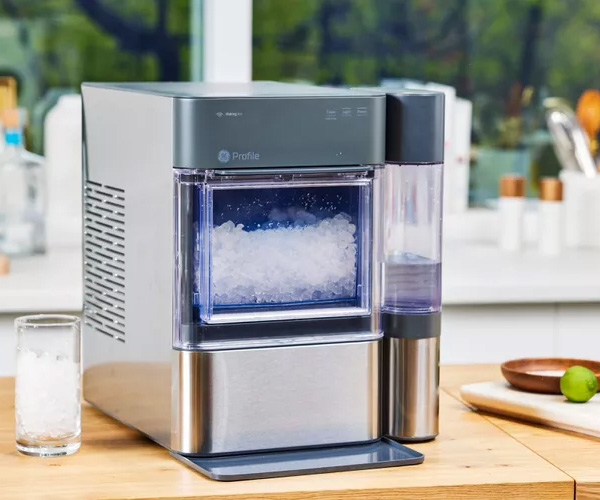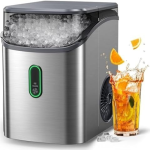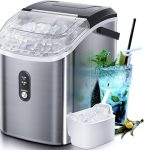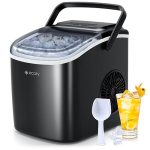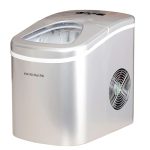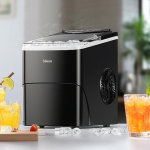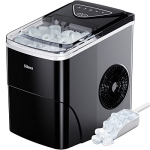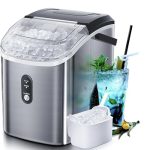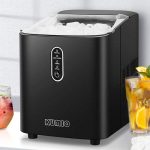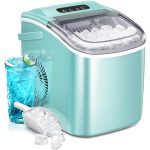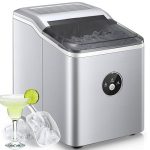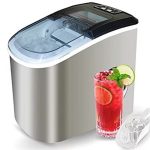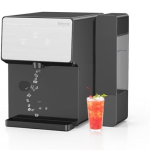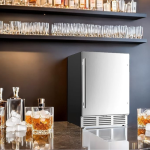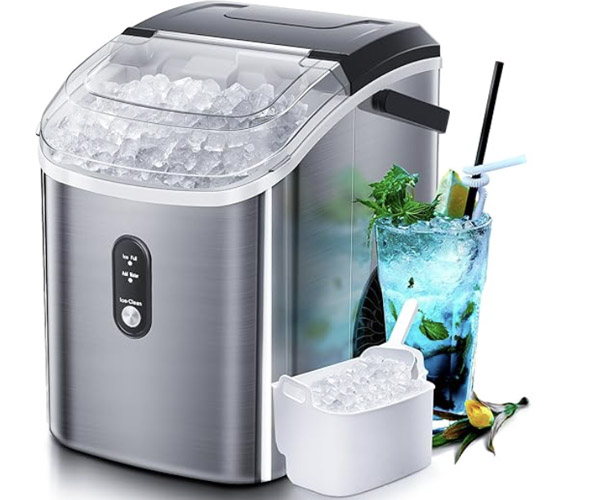Introduction
In the realm of modern conveniences, having a reliable and efficient ice maker at home can significantly enhance your lifestyle. Whether you’re hosting a summer barbecue, enjoying a refreshing drink after a long day, or preparing a large batch of ice for a party, a countertop ice maker with a water line connection ensures you always have a steady supply of ice at your disposal. This guide is designed to help you navigate the world of countertop ice makers, with a particular focus on models that feature a water line connection. By the end of this article, you will be equipped with the knowledge to choose the best countertop ice maker with water line connection for your needs.
Section 1: Understanding Countertop Ice Makers
1.1 What are Countertop Ice Makers?
Countertop ice makers are compact appliances designed to produce ice quickly and efficiently, right on your kitchen counter. These machines are smaller than undercounter or freestanding models but are capable of producing a significant amount of ice. They are ideal for homes, offices, and small businesses where space is at a premium.
Comparison with Other Types of Ice Makers
- Portable Ice Makers: Unlike portable ice makers, which require manual refilling of the water reservoir, countertop models with a water line connection can continuously produce ice without the need for frequent refills. Portable ice makers are suitable for occasional use and can be taken on trips, but they are less convenient for regular, high-volume ice production.
- Undercounter Ice Makers: These are built into cabinetry and provide a more permanent ice-making solution. They have larger capacities but also require more space and a more complex installation process. Countertop ice makers offer a middle ground, providing ample ice production without the need for extensive installation.
- Freestanding Ice Makers: Freestanding models are typically larger and used in commercial settings. They can produce vast quantities of ice and are designed to be placed anywhere with access to a water line and power outlet. Countertop ice makers are more compact and suitable for home use, offering the benefits of a freestanding model without the size and capacity that might be excessive for household needs.
1.2 How Do Countertop Ice Makers Work?
Understanding how a countertop ice maker works can help you appreciate the features and benefits of different models, particularly those with a water line connection. https://amzn.to/3M0ND4k
Explanation of the Ice-Making Process
The ice-making process in a countertop ice makers involves several steps, which are facilitated by a series of key components:
- Water Intake: In models with a water line connection, water is automatically supplied to the ice maker from your home’s water supply. This continuous water supply ensures that the ice maker can produce ice without the need for manual refilling.
- Freezing: The water is directed into an ice mold, where it is frozen by the evaporator. The evaporator, typically a metal plate or grid, cools down significantly, causing the water to freeze into ice cubes. The freezing process is efficient, allowing the ice maker to produce ice quickly.
- Harvesting: Once the ice is formed, the ice maker enters the harvesting phase. The ice cubes are released from the mold and dropped into the storage bin. Some models use a slight warming mechanism to loosen the ice cubes, making it easier to harvest them without damage.
- Storage: The ice cubes are stored in an insulated bin to prevent them from melting. The storage bin ensures that you have a ready supply of ice at all times. In models with a water line connection, the ice-making cycle repeats automatically, maintaining a constant supply of ice.
Key Components
Several components are essential for the operation of a countertop ice maker:
- Compressor: The compressor is responsible for pumping refrigerant through the system, which absorbs heat from the water and facilitates the freezing process. It is a critical component for maintaining the efficiency and speed of ice production.
- Evaporator: The evaporator is where the water is frozen into ice. It usually consists of a metal plate or grid that cools down to freeze the water into ice cubes. The design and material of the evaporator can affect the quality and speed of ice production.
- Condenser: The condenser releases the heat absorbed by the refrigerant into the surrounding environment. This component ensures that the ice maker does not overheat and operates efficiently.
- Thermostat: The thermostat regulates the temperature within the ice maker to ensure consistent ice production. It helps maintain the optimal temperature for ice formation, preventing the ice from melting too quickly.
- Water Pump: In models with a water line connection, the water pump ensures a steady supply of water to the ice maker. This component is essential for maintaining continuous ice production without manual intervention.
By understanding these components and processes, you can better appreciate the benefits of features like the water line connection and why they are essential for efficient and hassle-free ice production. The convenience of a water line connection ensures that your ice maker can operate continuously without the need for manual refilling, making it an ideal choice for those who require a steady supply of ice.
With a solid understanding of what countertop ice makers are and how they work, we can now move on to exploring the advantages of water line connections and how they can enhance your ice-making experience.
Section 2: Advantages of Water Line Connection
2.1 Continuous Water Supply
One of the most significant advantages of a countertop ice maker with a water line connection is the continuous water supply it provides. This feature ensures that your ice maker is always ready to produce ice without the need for frequent manual refilling, which can be a hassle, especially during high-demand periods.

How Water Line Connections Provide a Continuous Supply of Water
A water line connection links your ice maker directly to your home’s water supply. This setup allows water to flow automatically into the ice maker whenever it needs more to produce ice. As a result, the ice maker can continuously produce ice without any interruption. This constant water supply is particularly beneficial for households that use a lot of ice, as it ensures that there is always enough ice available without the need for frequent maintenance.
Benefits Over Manual Refilling
Manual refilling requires you to monitor the water levels in the ice maker constantly and add water whenever it runs low. This process can be time-consuming and inconvenient, especially if you are using the ice maker frequently or for larger gatherings. A water line connection eliminates this need, providing a hassle-free ice-making experience. This feature is particularly useful in busy households, offices, and small businesses where the demand for ice is high.
2.2 Convenience and Time-Saving
The convenience and time-saving aspects of a countertop ice maker with a water line connection cannot be overstated. By automating the water supply, these ice makers significantly reduce the amount of manual intervention required, allowing you to focus on other tasks.
How Water Line Models Save Time and Effort
With a water line connection, the ice maker draws water directly from the water supply, meaning you don’t need to check and refill the water reservoir constantly. This feature saves a considerable amount of time and effort, especially during busy times when you need a continuous supply of ice. Additionally, because the ice maker is always ready to produce ice, you won’t have to wait for new ice to be made, making it highly convenient for spontaneous gatherings or events.
Ideal Scenarios for Using a Water Line Connected Ice Maker
Water line connected ice makers are ideal for various settings, including:
- Households with High Ice Demand: For large families or homes where ice is used frequently for drinks, cooking, and entertaining, a water line connection ensures a continuous supply of ice without constant refilling.
- Offices: In office environments where employees regularly use ice for their drinks, a water line connection keeps the ice maker operating smoothly without the need for manual refilling.
- Small Businesses: For small businesses like cafes, bars, and restaurants, having a reliable and continuous supply of ice is crucial. A water line connection helps maintain this supply effortlessly.
- Parties and Gatherings: During parties or gatherings, the demand for ice can be high. A water line connected ice maker ensures that you never run out of ice, keeping your guests happy and your event running smoothly.
2.3 Improved Ice Production
Consistent and efficient ice production is another significant advantage of having a countertop ice makers with a water line connection. These models can maintain a steady output of ice, ensuring that you always have enough for your needs.
Consistent Ice Production with a Water Line Connection
With a continuous supply of water, ice makers can produce ice more consistently and efficiently. There is no downtime for refilling the water reservoir, which means the machine can operate at its optimal capacity without interruption. This consistent production is especially beneficial in settings where a large amount of ice is needed regularly.
Comparison with Manual Fill Models
Manual fill models require frequent monitoring and refilling, which can interrupt the ice-making process and lead to inconsistent ice production. Additionally, the capacity of manual fill models is often limited by the size of the water reservoir. In contrast, models with a water line connection can produce more ice over a given period, as they are not constrained by the need for manual refilling. This makes them more suitable for households and businesses with high ice demands.
Section 3: Key Features to Consider
When choosing a countertop ice maker with a water line connection, it’s essential to consider various features to ensure you select a model that meets your needs and preferences.
3.1 Ice Production Capacity
The ice production capacity of an ice maker refers to the amount of ice it can produce in a 24-hour period. This capacity is a crucial factor to consider, as it determines whether the ice maker can meet your daily ice needs.
Importance of Matching Capacity to Household Needs
Choosing an ice maker with the right production capacity is essential to ensure that you have enough ice for your daily use. If the capacity is too low, you might run out of ice frequently, leading to inconvenience. On the other hand, an ice maker with a capacity that is too high might be unnecessarily large and consume more energy than needed.
How to Calculate Required Ice Production
To calculate the required ice production capacity, consider the following factors:
- Daily Usage: Estimate the amount of ice you use daily for drinks, cooking, and other purposes. For instance, a family of four might need around 4-6 pounds of ice per day, while a small business might require 20-30 pounds or more.
- Peak Usage Times: Consider peak times when ice usage might increase, such as parties, holidays, or hot summer days. Ensure the ice maker can handle these peak demands without running out of ice.
- Storage Capacity: Evaluate the storage capacity of the ice maker. Ensure that the ice bin can hold enough ice to meet your immediate needs, even during peak times.
By carefully assessing your daily and peak ice usage, you can select an ice maker with a production capacity that matches your needs.
3.2 Ice Type and Shape Options
Different ice makers produce various types and shapes of ice, each with unique characteristics and uses. Understanding these options can help you choose a model that produces the type of ice you prefer.
Common Ice Types
- Cube Ice: Standard ice cubes are versatile and commonly used in beverages. They melt slowly and are ideal for cooling drinks without diluting them too quickly.
- Nugget Ice: Also known as chewable ice, nugget ice is soft and easy to chew. It is popular in healthcare settings and for those who enjoy chewing ice.
- Flake Ice: Flake ice is often used in food presentation and preservation, such as in seafood displays or salad bars. It molds easily around products, keeping them fresh.
- Gourmet Ice: Gourmet or clear ice is typically larger and clearer than standard cubes. It is often used in upscale settings for cocktails and premium beverages.
Advantages and Uses of Different Ice Shapes
Understanding the advantages and specific uses of different ice shapes can help you choose the right ice maker for your needs:
- Cube Ice: Best for drinks as it provides optimal cooling and melts slowly. Ideal for households and general use.
- Nugget Ice: Ideal for those who enjoy chewing ice or for healthcare applications. Soft and easy to chew, making it a favorite for many.
- Flake Ice: Suitable for food preservation and display, as it molds easily around items. Commonly used in seafood and produce displays.
- Gourmet Ice: Perfect for premium beverages and cocktails due to its aesthetic appeal and slow melting properties. Adds a touch of sophistication to drinks.
By selecting an ice maker that produces the type and shape of ice that best suits your needs, you can enhance your overall experience and satisfaction.
3.3 Storage Capacity
The storage capacity of an ice maker is another crucial feature to consider. This refers to the amount of ice that can be stored in the machine’s bin at any given time.
Importance of Adequate Ice Storage
Having adequate ice storage is essential to ensure you always have enough ice on hand, especially during peak usage times. If the storage capacity is too low, you might run out of ice frequently, leading to inconvenience and frustration.
How to Determine the Right Storage Capacity
To determine the right storage capacity for your needs, consider the following factors:
- Daily Usage: Estimate the amount of ice you use daily and ensure the storage bin can accommodate it.
- Peak Times: Consider peak usage times and choose a storage capacity that can handle increased demand.
- Space Constraints: Ensure the ice maker fits within your available space while providing sufficient storage.
By carefully evaluating these factors, you can choose an ice maker with the appropriate storage capacity to meet your needs efficiently.
3.4 Build Quality and Durability
The build quality and durability of an ice maker are critical features that impact its performance and longevity. Investing in a well-built, durable ice maker can save you time and money in the long run.
Materials to Look For
High-quality materials contribute to the durability and performance of an ice maker. Look for the following materials when selecting an ice maker:
- Stainless Steel: Stainless steel components are durable, resistant to rust and corrosion, and easy to clean.
- High-Quality Plastics: Durable, BPA-free plastics can ensure longevity and safety.
- Robust Internal Components: High-quality internal components, such as compressors and pumps, are essential for reliable performance.
Indicators of Long-Lasting Construction
Several indicators can help you determine the build quality and durability of an ice maker:
- Warranty: A longer warranty period often indicates confidence in the product’s durability.
- Customer Reviews: Positive reviews and high ratings from other users can provide insight into the ice maker’s performance and longevity.
- Brand Reputation: Established brands with a history of producing reliable appliances are often a safer choice.
By selecting an ice maker made from high-quality materials and with a reputation for durability, you can ensure reliable performance and long-term satisfaction. https://amzn.to/3M0ND4k
3.5 Energy Efficiency
Energy efficiency is an important consideration for any appliance, including ice makers. Choosing an energy-efficient model can help you save on utility bills and reduce your environmental footprint.
Energy Star Ratings and Their Significance
Energy Star ratings are a useful indicator of an appliance’s energy efficiency. Ice makers with Energy Star certification meet strict energy efficiency guidelines set by the Environmental Protection Agency (EPA). These models are designed to use less energy while maintaining high performance, making them a smart choice for environmentally conscious consumers.
Tips for Choosing Energy-Efficient Models
To choose an energy-efficient ice maker, consider the following tips:
- Look for Energy Star Certification: Energy Star-certified ice makers are typically more efficient than non-certified models.
- Check Energy Consumption: Review the ice maker’s energy consumption specifications and choose a model with lower energy usage.
- Consider Size and Capacity: Larger ice makers generally consume more energy, so choose a size and capacity that match your needs without excess.
By selecting an energy-efficient ice maker, you can reduce your utility bills and contribute to environmental sustainability.
3.6 Noise Levels
The noise level of an ice maker can significantly impact your user experience, especially in quiet settings like homes or offices.
Impact of Noise Levels on User Experience
High noise levels can be disruptive and annoying, particularly in environments where peace and quiet are valued. An ice maker that operates quietly can enhance your overall experience and avoid disturbances.
How to Find Quieter Ice Maker Models
To find quieter ice maker models, consider the following tips:
- Check Noise Level Specifications: Look for noise level specifications in the product details. Models with lower decibel (dB) ratings are quieter.
- Read Customer Reviews: Customer reviews often mention the noise level of an ice maker. Look for feedback from users who prioritize quiet operation.
- Consider Build Quality: High-quality materials and construction can contribute to quieter operation.
By choosing a quieter ice maker, you can enjoy the benefits of a reliable ice supply without the disruption of excessive noise.
3.7 Ease of Cleaning and Maintenance
Regular cleaning and maintenance are essential to keep your ice maker in optimal condition. Features that facilitate easy cleaning and maintenance can save you time and effort.
Features That Facilitate Easy Cleaning
Several features can make cleaning and maintenance easier:
- Removable Parts: Ice makers with removable parts, such as ice bins and water reservoirs, are easier to clean.
- Self-Cleaning Functions: Some models come with self-cleaning functions that help keep the internal components clean with minimal effort.
- Easy Access: Ice makers with easy access to internal components make maintenance tasks simpler.
Regular Maintenance Tips
To maintain your ice maker in good condition, follow these regular maintenance tips:
- Clean the Ice Bin: Regularly clean the ice bin to prevent the buildup of mold and bacteria.
- Descale the Water System: Periodically descale the water system to remove mineral deposits that can affect performance.
- Check for Leaks: Regularly check for leaks in the water line and connections.
By choosing an ice maker with easy-to-clean features and following regular maintenance practices, you can ensure reliable performance and extend the lifespan of your appliance.
3.8 Size and Installation Requirements
The size and installation requirements of an ice maker are important considerations, especially for countertop models. Ensuring the ice maker fits within your available space and meets installation requirements is crucial.
Importance of Measuring Space
Before purchasing an ice maker, measure the available space to ensure it will fit comfortably. Consider the following dimensions:
- Height: Ensure there is enough vertical clearance for the ice maker.
- Width: Measure the width of the space to accommodate the ice maker.
- Depth: Consider the depth of the countertop or installation area.
Key Considerations for Installation
In addition to space, consider the following installation requirements:
- Ventilation: Ensure there is adequate ventilation around the ice maker to prevent overheating.
- Water Line Connection: For models with a water line connection, ensure there is easy access to a water source.
- Power Source: Ensure there is a nearby power outlet to plug in the ice maker.
By carefully measuring your space and considering installation requirements, you can choose an ice maker that fits perfectly and operates efficiently.
With a comprehensive understanding of the key features to consider, let’s move on to the installation and maintenance of water line models, ensuring you get the most out of your countertop ice makers.
Section 4: Installation and Maintenance of Water Line Models
4.1 Installation Process
Installing a countertop ice maker with a water line connection can seem daunting, but with the right guidance, it can be straightforward. Here’s a step-by-step guide to help you through the process.
Step-by-Step Guide to Installing a Water Line Connection
- Choose the Location: Select a suitable location for your ice maker, ensuring there is enough space for ventilation and access to a water line and power outlet.
- Gather Tools and Materials: You will need a drill, adjustable wrench, Teflon tape, water line kit, and a bucket.
- Turn Off Water Supply: Before starting, turn off the water supply to prevent any leaks or spills.
- Connect the Water Line: Attach the water line kit to your home’s water supply. Use Teflon tape on the threads to ensure a tight seal and prevent leaks.
- Run the Water Line to the Ice Maker: Drill a hole in the countertop or cabinet if necessary, and run the water line from the supply to the back of the ice maker.
- Attach the Water Line to the Ice Maker: Connect the water line to the inlet valve on the ice maker. Ensure it is tightly secured to prevent any leaks.
- Turn On the Water Supply: Once everything is connected, turn the water supply back on and check for any leaks.
- Plug In and Test the Ice Maker: Plug in the ice maker, turn it on, and run a few cycles to ensure everything is working correctly.
Common Challenges and How to Overcome Them
- Leaking Connections: Ensure all connections are tight and use Teflon tape to seal any threaded connections.
- Low Water Pressure: Check the water supply valve and ensure it is fully open. If the pressure is still low, you may need to check the main water supply for issues.
- Incorrect Installation: Follow the manufacturer’s instructions carefully and consult a professional if you are unsure about any step.
4.2 Maintenance Tips
Regular maintenance is crucial to keep your ice maker functioning efficiently and to ensure the quality of the ice it produces.
Regular Checks for Leaks
Periodically check all connections and the water line for any signs of leaks. Early detection can prevent water damage and maintain the efficiency of your ice maker.
Cleaning the Water Line
Over time, mineral deposits can build up in the water line, affecting the quality of the ice and the efficiency of the ice maker. To clean the water line:
- Turn Off the Ice Maker: Disconnect the ice maker from the power supply.
- Disconnect the Water Line: Carefully disconnect the water line from the ice maker and the water supply.
- Flush the Water Line: Use a mixture of water and vinegar or a commercial descaling solution to flush out the water line. Run the solution through the line and rinse thoroughly with clean water.
- Reconnect and Test: Reconnect the water line, turn on the water supply, and test the ice maker to ensure it is working correctly.
Importance of Water Filters and How to Change Them
Water filters help remove impurities from the water, ensuring the ice is clean and clear. Regularly changing the water filter is essential to maintain the quality of the ice.
- Locate the Filter: Find the water filter on your ice maker. It is usually located near the water inlet valve.
- Turn Off the Water Supply: Before changing the filter, turn off the water supply to prevent leaks.
- Remove the Old Filter: Twist or pull the old filter out, following the manufacturer’s instructions.
- Install the New Filter: Insert the new filter and secure it in place. Ensure it is properly seated to prevent leaks.
- Turn On the Water Supply and Test: Turn the water supply back on and test the ice maker to ensure everything is functioning correctly.
By following these maintenance tips, you can ensure your countertop ice maker with water line connection continues to operate efficiently and produce high-quality ice.
Section 5: Evaluating Different Brands and Models
Choosing the right brand and model is crucial to ensuring you get a high-quality ice maker that meets your needs. Here’s what you should consider when evaluating different options.
5.1 Popular Brands and Their Offerings
Several brands are known for producing high-quality countertop ice makers with water line connections. Here are some of the top brands and what they offer:
- Whirlpool: Known for their durable and efficient appliances, Whirlpool offers a range of countertop ice makers with advanced features such as self-cleaning functions and energy-efficient designs.
- Frigidaire: Frigidaire ice makers are popular for their reliability and user-friendly designs. Many models include features like quick ice production and multiple ice size options.
- GE Appliances: GE is a trusted name in home appliances, offering ice makers with robust construction and advanced features like smart connectivity and intuitive controls.
- NewAir: NewAir provides a variety of ice makers that are praised for their performance and innovative features, including rapid ice production and compact designs suitable for small spaces.
5.2 Customer Reviews and Ratings
Customer reviews and ratings are valuable resources when evaluating different ice maker models. They provide insights into real-world performance and user satisfaction.
Importance of Reading Customer Reviews
Reading customer reviews can help you understand the pros and cons of a particular model. Look for reviews that mention:
- Ease of Installation: Check if users found the installation process straightforward.
- Performance: Look for feedback on ice production capacity, speed, and consistency.
- Durability: Pay attention to comments about the build quality and longevity of the ice maker.
- Noise Levels: Note any mentions of noise levels during operation.
- Customer Service: Consider feedback on the brand’s customer service and support.
How to Interpret Ratings and Feedback
When interpreting ratings and feedback, consider the overall rating and the number of reviews. A high rating with a large number of reviews generally indicates a reliable product. However, also read the detailed reviews to understand specific issues or recurring problems that users might have experienced.
5.3 Cost Considerations
Cost is an important factor when choosing a countertop ice maker with a water line connection. While initial purchase price is a consideration, it’s also important to think about long-term costs. https://amzn.to/3M0ND4k
Initial Purchase Cost vs. Long-Term Benefits
While it might be tempting to choose a less expensive model, consider the long-term benefits of investing in a higher-quality ice maker. More expensive models often come with better build quality, advanced features, and longer warranties, which can save you money on repairs and replacements in the long run.
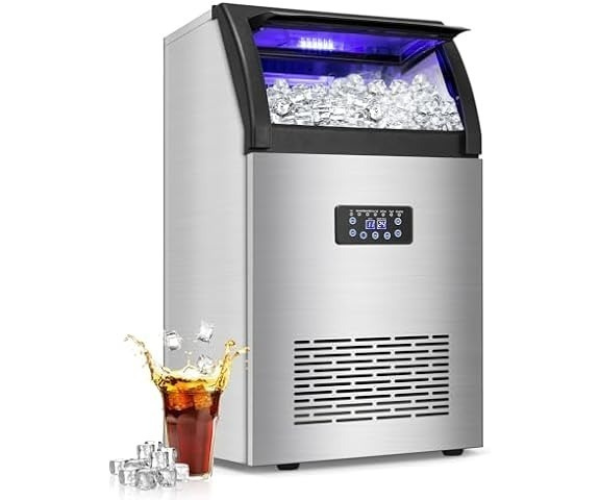
Budgeting for Installation and Maintenance
When budgeting for your ice maker, also consider the costs associated with installation and maintenance. For water line models, you might need to invest in a water line kit and potentially professional installation. Additionally, factor in the cost of regular maintenance, such as replacing water filters and cleaning supplies.
By carefully evaluating different brands, reading customer reviews, and considering the overall cost, you can make an informed decision and choose the best countertop ice makers with water line connection for your needs.
Section 6: Making the Right Choice
Selecting the right countertop ice maker with a water line connection involves assessing your needs and matching them with the features of different models. Here’s how to make an informed decision.
6.1 Assessing Your Needs
Understanding your specific needs is the first step in choosing the right ice maker. Consider the following factors:
- Usage Frequency: How often do you plan to use the ice maker? For frequent use, a model with a high production capacity and continuous water supply is essential.
- Volume of Ice Needed: Estimate the amount of ice you need daily. For larger families or businesses, a higher production capacity is crucial.
- Space Availability: Measure the available space in your kitchen or bar area to ensure the ice maker fits comfortably.
6.2 Matching Features to Your Requirements
Once you have a clear understanding of your needs, identify the features that are most important to you:
- Ice Production Capacity: Choose a model that can produce enough ice to meet your daily and peak usage needs.
- Ice Type and Shape: Select an ice maker that produces the type of ice you prefer, whether it’s cube, nugget, flake, or gourmet ice.
- Storage Capacity: Ensure the ice maker has sufficient storage capacity to hold the ice you need.
- Build Quality and Durability: Look for models made from high-quality materials and with a reputation for durability.
- Energy Efficiency: Consider energy-efficient models to save on utility bills.
- Noise Levels: If noise is a concern, choose a quieter model.
- Ease of Cleaning and Maintenance: Opt for models with features that make cleaning and maintenance easy.
6.3 Final Decision-Making Tips
To make a confident and informed decision, follow these tips:
- Compare Multiple Models: Don’t settle for the first model you come across. Compare multiple models based on their features, reviews, and prices.
- Read Detailed Reviews: Pay attention to detailed reviews that provide insights into the performance, durability, and user experience of the ice maker.
- Consider Long-Term Costs: Think about the long-term costs of owning and maintaining the ice maker, not just the initial purchase price.
- Seek Professional Advice: If you’re unsure about installation or specific features, seek advice from professionals or contact the manufacturer’s customer service.
By carefully assessing your needs, matching features to your requirements, and considering long-term costs, you can choose the right countertop ice maker with water line connection that will serve you well for years to come.
Section 7: Troubleshooting Common Issues
Even with the best ice makers, you might encounter some issues. Here’s how to troubleshoot common problems with water line connected ice makers.
7.1 Common Problems with Water Line Connections
Identifying and Fixing Leaks
Leaks can occur at the connection points or along the water line. To fix leaks:
- Check Connections: Ensure all connections are tight and sealed with Teflon tape if necessary.
- Inspect the Water Line: Look for any cracks or damage along the water line and replace it if needed.
- Monitor the Ice Maker: After fixing the connections, monitor the ice maker for any signs of leakage.
Low Water Pressure Issues
Low water pressure can affect the performance of your ice maker. To address this issue:
- Check the Water Supply Valve: Ensure the valve is fully open and not restricted.
- Inspect the Water Line: Look for any kinks or blockages in the water line that could be reducing pressure.
- Consult a Professional: If the pressure remains low, consult a professional plumber to check your home’s water pressure and make any necessary adjustments.
Ice Maker Not Producing Ice
If your ice maker is not producing ice, try the following troubleshooting steps:
- Check the Water Supply: Ensure the water supply is turned on and the water line is properly connected.
- Inspect the Ice Maker: Check for any error messages or indicator lights that might provide clues to the problem.
- Reset the Ice Maker: Try resetting the ice maker according to the manufacturer’s instructions.
- Consult the Manual: Refer to the user manual for troubleshooting tips specific to your model.
- Contact Customer Service: If the issue persists, contact the manufacturer’s customer service for assistance.
7.2 When to Call a Professional
While some issues can be resolved with basic troubleshooting, others might require professional help. Here’s when to call a professional:
- Persistent Leaks: If you cannot fix leaks or if they reoccur frequently, it’s best to consult a plumber.
- Electrical Problems: Any issues with the electrical components of the ice maker should be handled by a professional to ensure safety.
- Complex Installation Issues: If you’re unsure about any part of the installation process, seek professional help to avoid potential damage or incorrect setup.
- Warranty and Repairs: For any problems covered under warranty or requiring specialized repairs, contact the manufacturer or an authorized service provider.
By knowing how to troubleshoot common issues and when to call a professional, you can ensure your countertop ice maker with water line connection remains in good working order.
Conclusion
Choosing the right countertop ice maker with water line connection can significantly enhance your convenience and enjoyment at home. By understanding the different types of ice makers, the benefits of water line connections, and the key features to look for, you can make an informed decision that meets your needs. Regular maintenance and proper installation are crucial to ensure your ice maker operates efficiently and lasts for years. With the right model, you’ll always have a steady supply of ice ready for any occasion.
FAQs
FAQ 1: Can I install a water line connection myself?
Yes, many countertop ice makers with water line connections come with detailed installation instructions that make it possible to install the water line yourself. However, if you are not comfortable with the installation process or encounter any difficulties, it is advisable to seek professional assistance to ensure proper setup and avoid potential issues.
FAQ 2: How often should I clean my ice maker’s water line?
It is recommended to clean the water line every six months to a year, depending on the hardness of your water and the frequency of use. Regular cleaning helps prevent mineral buildup and ensures the quality of the ice. If you notice any decrease in ice production or changes in ice quality, it might be time to clean the water line.
FAQ 3: What should I do if my ice maker stops working?
If your ice maker stops working, first check the water supply and ensure the water line is properly connected. Next, inspect the ice maker for any error messages or indicator lights that might provide clues to the problem. Try resetting the ice maker according to the manufacturer’s instructions. If the issue persists, refer to the user manual for troubleshooting tips or contact the manufacturer’s customer service for assistance.
FAQ 4: Are ice makers with water line connections more expensive?
Ice makers with water line connections can be more expensive than manual fill models due to the added convenience and continuous ice production they offer. However, the long-term benefits, such as time saved from not having to refill the water reservoir and the consistent ice production, often outweigh the initial higher cost.
FAQ 5: What type of water filter is best for ice makers?
The best type of water filter for your ice maker depends on your specific water quality. Carbon filters are effective at removing chlorine, odors, and some contaminants, making them a popular choice. Reverse osmosis filters provide a higher level of purification by removing a broader range of contaminants, including minerals that can cause scale buildup. Check the manufacturer’s recommendations for compatible filters and choose one that suits your water quality needs. https://amzn.to/3M0ND4k
RReferences
- GE Profile Opal Nugget Ice Maker Product Page
- NewAir Countertop Ice Maker Product Page
- Igloo ICEB26HNBK Portable Electric Countertop Ice Maker Product Page
- Scotsman SCN60PA-1SS
- EUHOMY Nugget Ice Maker Countertop
- Silonn Ice Maker Countertop
Additional Resources
[Which countertop ice maker with freezer is best?]
[How often should you clean your countertop ice maker?]
[What happens if you don’t clean your countertop ice maker regularly?]
[How does a countertop ice maker work?]
[How to install a countertop ice maker?]
[How often to descale a countertop ice maker?]
[Buying Guide: Countertop Ice Makers with Water Line Connection]
[Kitchen Upgrade Ideas: Countertop Ice Makers with Water Line]

